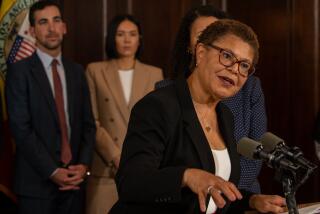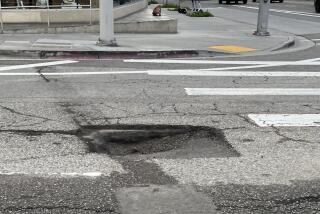Local Councils Press Hahn for More Funding
- Share via
A year after the state shut down the popular playground in Bee Canyon Park for safety reasons, new equipment is finally being installed this month. But the Granada Hills North Neighborhood Council is picking up the bill, not the Los Angeles parks department.
Officials with the Department of Recreation and Parks pleaded poverty, so frustrated members of the neighborhood council stepped in, along with Councilman Greig Smith.
“The park is a big part of the community,” said Mary Ellen Crosby, the neighborhood council member who headed the project. “We have a lot of children in this community and they really missed it.”
But the project cost the neighborhood council $25,000, half of its annual allocation from the city of Los Angeles.
Nearly two years after the city began giving each of its neighborhood councils $50,000 per year, leaders of the panels throughout Los Angeles have concluded that it’s not enough for them to do the meaningful work they would like to accomplish.
Presidents of neighborhood councils have begun urging Mayor James K. Hahn and his opponents in the upcoming election to increase the allocation to between $100,000 and $500,000 so that councils can better address community needs.
“The neighborhood councils are vastly underfunded, and that’s a big part of our problem,” said Jim Alger, a member of the Northridge West Neighborhood Council, a point he has conveyed to the main mayoral candidates.
Citing city budget woes, Hahn spokeswoman Sahar Moridani confirmed that there is no plan to increase the councils’ budgets in the fiscal year that begins July 1. Moridani said she could not rule out an increase in future years, but added that the mayor is pleased by how the councils have spent their money.
“It’s been a great tool that they have been able to use specifically to improve their communities,” Moridani said.
City Councilwoman Jan Perry said it is premature to talk about increasing the allocation. “It’s enough as it is,” she said. “They need to establish a track record with the money they have.”
Twenty months after the city began funding neighborhood councils, 70 have received $1.5 million.
The councils are filling in to pay for neglected community needs: fixing sidewalks, planting flowers in street medians, installing signs and buying books for school libraries.
Of the $747,800 allocated so far this fiscal year, nearly half, $356,800, has been spent on community improvement projects, with the rest going to operating expenses, mailers on local issues, setup costs for voicemail and computer websites, and training.
But $50,000 only goes so far when councils want to pay for improvement projects that the city has not funded, members say.
When the Studio City Neighborhood Council wanted to revitalize the intersection of Laurel Canyon and Ventura boulevards, it found that the project would cost $25,000.
In Granada Hills, Crosby agrees that more should be budgeted to do community improvement projects and operate effectively.
Other expenses by Crosby’s council have included $5,000 for a safety fair, $500 for an information kiosk in the park, $100 for an egg hunt and $700 to rent two buses to bring opponents of the Sunshine Canyon Landfill to a water board hearing on the dump.
“In my opinion, $50,000 is not nearly enough to promote outreach, and do the things we want to do,” said Steve Twining, president of the Bel-Air Beverly Crest Neighborhood Council.
Twining’s group has donated two speed guns to the West Los Angeles police station and one to the school district police. The group has paid for food at meetings, copies of agendas and an office on Sepulveda Boulevard, which is staffed with a part-time employee. That leaves little to pay for communications with residents and street and sidewalk improvement, Twining said.
For the Mid-Town North Hollywood Neighborhood Council, the problem is reaching out to 69,000 residents to involve them in city government, said Diane Corral, the council’s president.
“For our area it is not enough,” Corral said of the $50,000, noting the same amount is given to the Toluca Lake Neighborhood Council, which serves about 14,000 residents.
Voters approved the neighborhood council system in 1999, and the councils began forming in 2001. There are now 84.
In response to complaints that the councils had no say in the spending of city funds, and could not even afford to send mailers announcing meetings, Hahn agreed to give each $50,000 per year.
Council leaders complain that the city is slow in reimbursing checks or approving big expenditures. “To get a single check, we have to go through an obstacle course of paperwork,” said Hallie Kemper, president of the Greater Valley Glen Council.
Twining said a recent USC study found that Los Angeles spends $2 per resident on neighborhood councils compared with $13 to $20 by cities such as Seattle; Portland, Ore.; and Minneapolis.
Greg Nelson, general manager of the city Department of Neighborhood Empowerment, said that, with many city departments seeing their budgets slashed, the councils should not expect to see an increase. “Just to stay where they are is going to be a major victory,” he said.
Nelson said he urges neighborhood councils to be frugal. When one wanted to spend much of its annual grant on a retreat in Palm Springs, Nelson stepped in and urged prudence. The council held its retreat at a hotel in the harbor area of Los Angeles.
More to Read
Sign up for Essential California
The most important California stories and recommendations in your inbox every morning.
You may occasionally receive promotional content from the Los Angeles Times.














